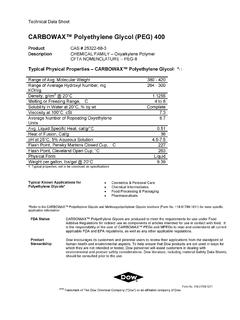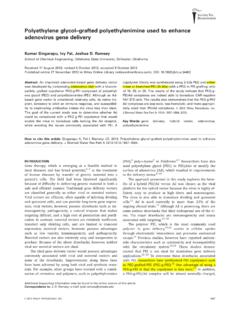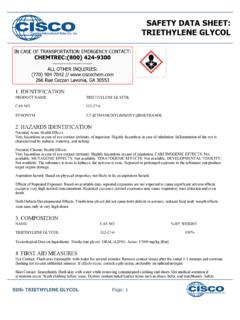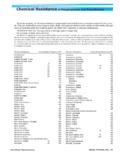Transcription of 003 08/02/07 VANWET 9N9 NONYLPEENOL POLYETHYLENE …
1 003 08/02/07 VANWET 9N9 NONYLPEENOL POLYETHYLENE glycol ETHER PRODUCT NAME: VANWET 9N9 NONYLPHENOL POLYETHYLENE glycol ETHER MSDS NUMBER: UZNOO24J DATE ISSUED: 07/12/2007 SUPERSEDES: 02/24/2003 ISSUED BY: 008360 * * * * * * * * * * * * * * * * * * * * * * * * * * * * * * * * * * * * * * * * * * * * * * * * * * * * * * * * Material Safety Data Sheet 1. Product and Company Identification Product Name VANNET 9N9 NONYLPEENOL POLYETHYLENE glycol ETHER Distributed by: Univar USA Inc. 17425 NE Union Hill Road Redmond, WA 98052 4258893400 2. Hazards Identification Emergency Overview Color: Brown Physical State: Liquid Odor: Mild Hazards of product: WARNING!
2 Causes eye irritation. Harmful if inhaled. May be harmful if absorbed through skin. May be harmful if swallowed. Aspiration hazard. Can enter lungs and cause damage. Isolate area. Keep up wind of spill. OSHA Hazard Communication Standard This product is a Hazardous Chemical as defined by the OSHA Hazard Communication Standard, 29 CER Potential Health Effects Eye Contact: May cause severe eye irritation. May cause severe corneal injury. Skin Contact: Prolonged contact may cause slight skin irritation with local redness. Skin Absorption: Prolonged skin contact is unlikely to result in absorption of harmful amounts. Similar materials have been shown to cause lung effects following contact with the skin of rabbits.
3 Inhalation: Prolonged excessive exposure may cause serious adverse effects, even death. Vapor may cause irritation of the upper respiratory tract (nose and throat). Mist may cause irritation of upper respiratory tract (nose and throat). Ingestion: Low toxicity if swallowed. Small amounts swallowed incidentally as a result of normal handling operations are not likely to cause injury; however, swallowing larger amounts may cause injury. Aspiration into the lungs may occur during ingestion or vomiting, causing lung damage or even death due to chemical pneumonia. Effects of Repeated Exposure: For this family of materials: In animals, effects have been reported on the following organs: Kidney.
4 Liver. Birth Defects/Developmental Effects: For this family of materials: Has been toxic to the fetus in lab animals at doses toxic to the mother. 3. Composition Information Component CAS # Amount Poly (oxy-1, 2-ethanediyl), alpha- 127087-87-0 >= % (4-nonylphenyl) -omega-hydroxy-branched Poly (ethylene oxide) 25322-68-3 <= % Dinonyiphenyl polyoxysthylene 9014-93-1 < % 4.
5 First Aid Measures Eye Contact: Immediately flush eyes with water; remove contact lenses, if present, after the first 5 minutes, then continue flushing eyes for at least 15 minutes. Obtain medical attention without delay, preferably from an ophthalmologist. Skin Contact: Wash skin with plenty of water. Inhalation: Move person to fresh air. If not breathing, give artificial respiration; if by mouth to mouth use rescuer protection (pocket mask, etc). If breathing is difficult, oxygen should be administered by qualified personnel. Call a physician or transport to a medical facility. Ingestion: Do not induce vomiting. Call a physician and/or transport to emergency facility immediately.
6 Notes to Physician: Maintain adequate ventilation and oxygenation of the patient. Respiratory symptoms, including pulmonary edema, may be delayed. Persons receiving significant exposure should be observed for 24-48 hours for signs of respiratory distress. The decision of whether to induce vomiting or not should be made by a physician. If lavage is performed, suggest endotracheal and/or esophageal control. Danger from lung aspiration must be weighed against toxicity when considering emptying the stomach. No specific antidote. Treatment of exposure should be directed at the control of symptoms and. the clinical condition of the patient. 5. Fire Fighting Measures Extinguishing Media: Water fog or fine spray.
7 Dry chemical fire extinguishers. Carbon dioxide fire extinguishers. Foam. Do not use direct water stream. May spread fire. Alcohol resistant foams (ATC type) are preferred. General purpose synthetic foams (including AFFF) or protein foams may function, but will be less effective. Fire Fighting Procedures: Keep people away. Isolate fire and deny unnecessary entry. Burning liquids may be extinguished by dilution with water. Do not use direct water stream. May spread fire. Burning liquids may be moved by flushing with water to protect personnel and minimize property damage. Special Protective Equipment for Firefighters: Wear positive-pressure self contained breathing apparatus (SCBA) and protective fire fighting clothing (includes fire fighting helmet, coat, trousers, boots, and gloves).
8 If protective equipment is not available or not used, fight fire from a protected location or safe distance. Unusual Fire and Explosion Hazards: Violent steam generation or eruption may occur upon application of direct water stream to hot liquids. Hazardous Combustion Products: During a fire, smoke may contain the original material in addition to combustion products of varying composition which may be toxic and/or irritating. Combustion products may include and are not limited to: Carbon monoxide. Carbon dioxide. 6. Accidental Release Measures Steps to be taken if Material is Released or Spilled: Contain spilled material if possible. Absorb with materials such as: Sand or Dirt.
9 Collect in suitable and properly labeled containers. Do not use water for cleanup. See Section 13, Disposal Considerations, for additional information. Personal Precautions: Isolate area. Keep unnecessary and unprotected personnel from entering the area. Keep upwind of spill. Ventilate area of leak or spill. Use appropriate safety equipment. For additional information, refer to Section 8, Exposure Controls and Personal Protection. Refer to Section 7, Handling, for additional precautionary measures. Environmental Precautions: Prevent from entering into soil, ditches, sewers, waterways and/or groundwater. See Section 12, Ecological Information. 7. Handling and Storage General Handling: Avoid contact with eyes, skin, and clothing.
10 Avoid breathing vapor. Do not swallow. Wash thoroughly after handling. Keep container closed. Use with adequate ventilation. See Section 8, EXPOSURE CONTROLS AND PERSONAL PROTECTION. Storage: No specific requirements. Shelf life: Use within 24 Months. The shelf life given is for unopened containers stored under moderate temperature conditions 8. Exposure Controls / Personal Protection Exposure Limits Component List Type Value Poly (ethylene oxide) WEEL TWA Particulate. 10 mg/m3 Personal Protection Eye/Face Protection: Use chemical goggles.














